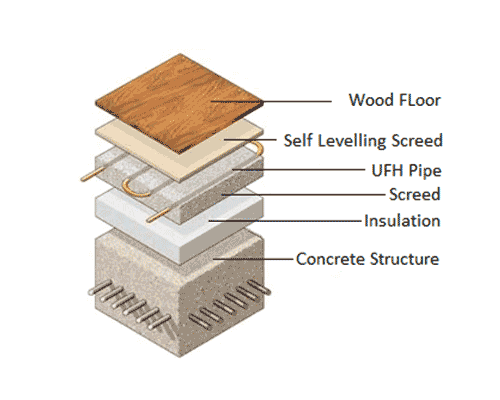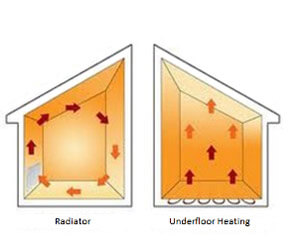
How Does It Work?
In a ‘wet’ system, pipework is laid in or under the floor. In the floor if the floor is solid (screed or concrete), or under it if it is suspended timber joists.
As warm water is passed through the pipework heat percolates into the surrounding floor and as a result the floor heats the room. In effect, the floor has become a gigantic radiator.
In a solid floor construction, insulation should be installed under the slab to negate the cooling effect of the earth below, and thereby avoiding heat loss into the ground.
With suspended timber floors the pipework is installed between the joists. To avoid heat loss through convection in the void below, a reflecting medium (quilt or tray) is installed beneath the pipework which insulates and also reflects heat upward.

Underfloor Heating Benefits
Comfort
One of the many floor heating advantages is that it heats the whole floor area you in which you live. This generates the opposite heat cycle to that of conventional heat sources and results in warm feet and consistent room temperatures. Compared to conventional radiators, an underfloor heating system generates more radiant heat as opposed to convective heat.
Freedom of room design
This solution requires no wall space and so allows you complete freedom to design your room layout without compromise. You have the flexibility to locate your furniture where you wish, suiting your lifestyle needs and not your heating system as no space is lost to radiators.
Low Cost Efficient Heating
A further key advantage is the low costs of operation. Due to its large area it requires much lower water temperatures with which to heat a room compared to radiators. These lower temperatures can be much more efficiently produced by boilers and particularly renewable energy heat pumps.
Key Selection Questions
Which Underfloor Heating Installation is Best; Electric or Water?
Both systems achieve the same thing, 21 degrees is 21 degrees whether you use electric or water. As a rule of thumb warm water systems are cheaper to run over the long term, electric underfloor heating can be cheaper to install but costs more over the longer term. We generally recommend water systems wherever possible due to their more economical nature.
How Much Does It Cost to Run?
Water underfloor heating systems are typically 20% cheaper to run than a traditional radiator system powered by a Gas boiler.
What Floor Coverings Can I Have?
You can have almost any type of floor covering. This includes but not limited to: Amtico, Karndean, Marmoleum, Laminate, Engineered Wood, Carpet, Tiles and Stone.
Do I Need Floor Insulation?
Yes, we strongly recommend the use of insulation otherwise you could have a heating system that is very un-economical to run. More insulation is better in this situation where floor heights permit.
Key System Components



